 |
Organic Society
Roncal Valley - Part II
The Tribute of the Three Cows
Hugh O’Reilly
After the victory of Poitiers, when the Franks expelled from Gaul the Arab armies coming from Spain, an interesting custom developed among the mountain people of the Pyrenees. At certain borders along the mountain passes, they would place stones, or mugas, under the invocation of St. Martin, Patron of France, asking him to protect the roads from the Moors and other enemies.

The Ernaz Stone, one of the last remaining border stones separating Roncal Valley from France |
The most famous of these border stones of St. Martin – almost the only one whose name has endured to our days – is the Stone of Ernaz, placed in a high, solitary site on the northernmost mountain of the Pyrenees where Bearn (France) meets the Spanish territories of Navarre and Aragon.
On this remote and solitary mountain of the Pyrenees that stands around 6,500 feet above sea level, a curious and most solemn ceremony takes place on July 13 of every year whose origin has been lost in the mists of legend. On that day, in good or bad weather, under the scorching mountain sun or in the misty wet fog, two groups – one coming from each side of the Pyrenees – gather near the Ernaz Stone at around 10 o’clock in the morning. There is no need to confirm the place or time. Year after year, century after century, each side knows that the other will be present there at the correct hour.
On one side of the border, the mayors of the Baretous Valley in Bearn, France stand. On the other side are the mayors of the General League of the Roncal Valley in Navarre, Spain. Both sides are accompanied by local authorities, area shepherds, guards and militia, as well as groups of curious onlookers whose numbers increase each year. It was not so long ago that these groups would reach the Ernaz Stone only after hours of hard climbing, before new paved roads shortened the distance and eased the way.
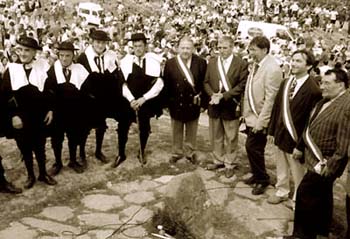
The mayors of Roncal Valley, at left, meet the mayors of Bearn, rance |
The ceremony of the now famous Tribute of the Three Cows begins at around 11 in the morning. The mayors of the Roncal Valley stand in their traditional Roncalese clothing and hats, their pants laced under their knees, black mantles covered with square white collars, and black hats with short upturned rims, their ceremonial garb. The scene with its stone backdrop returns one suddenly to the Middle Ages. It is a fleeting leap into a thousands-year-old past.
The mayor of the town of Isaba, who acts as president of the League for this ceremony, carries a staff, the symbol of his authority. He is surrounded by the other mayors, the League secretary and witnesses, who stand on the Spanish side of the border stone. On its other side are the mayors of the French villages, who wear their tri-colored emblems across their chests as a sign of their authority. The guards sound the alert that the ceremony will begin and silence falls.
Then the Roncalese mayor asks in a loud voice: “Are you coming, as in past years, to pay the tribute?” The mayors from Baretous respond, also in Spanish, “We are, señor.” The Roncalese mayor asks the same question a second and third time, each time receiving the same response. Then the president of the mayors calls out the same formula repeated since bygone times: “Pax avant!” [So, let there be peace.] The mayors of Baretous repeat the words.
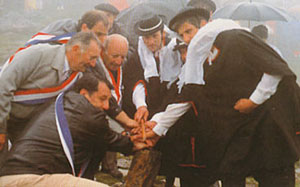
The Ceremony of the Hands, a symbol of the peace
and good relations |
Then the ceremony of the hands follows. The mayors from both sides place their hands atop the border stone, as a symbol of the peace. Over all the hands are those of the mayor of Isaba, as the sign of his authority.
Next, the mayors of Baretous present the cattle they had herded up the mountain earlier that morning. From their numbers, the Roncalese choose three, which are accepted as a centuries-old tribute and pledge of peace.
Finally, the Roncalese mayor, as president of the ceremony and lord of the territory, receives the oath of fidelity from the mountain guards of both the Roncal and Baretous Valleys. Afterwards, he dismisses them, saying: “If you fulfill your word, may God reward you. If not, may He judge you.” Then he addresses the audience, asking that anyone with a grievance against the peace in the past year step forward and speak.
With this, the ceremony ends, and all retire to a gazebo erected for the event, where the Roncalese offer a luncheon – all meat – for the French and Spanish authorities present. The meal ends with a coffee offered by the French mayors. During the meal, the language, as in the ceremony, is Spanish. So also, a good country Spanish wine is offered to the guests, who joyfully fraternize.
The origin of the tribute
The records of Roncal Valley describe this ancient ritual with these words:
“It is difficult to find in Navarre or any other kingdom or province such a honor as that of the Roncal Valley, which from ancient times receive a tribute from the inhabitants of the Baretous Valley and its neighbors, vassals of the Most Christian King [of France]. This tribute consists in offering three cows with good teeth, hide, and horns every year on the border that divides the two kingdoms. It is a homage paid by those of Baretous in order to maintain the peace and in submission to the Roncalese.
“If on some occasions, one of the three cows was rejected for lacking one of the three aforementioned qualities, it would be replaced later at night in the square of Isaba to avoid the shame of doing so in the daylight, and avoid giving the impression that the French made light of the service they render to Spain and considered themselves dispensed from the tribute.”
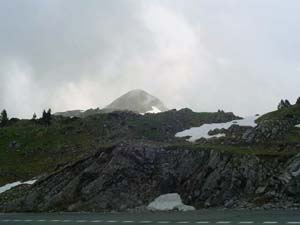
Arlas Peak, or the Peak of Contention
where the great dispute began |
At the Ernaz Stone where the ceremony takes place, one can see a mountain peak that rises above everything, standing at some 7,000 feet. It is the Arlas Peak, also called the Peak of Contention, the silent witness to the legendary fight that gave rise to the tribute.
Some authors place its origin all the way back to the Cimbric invasion 125 years before Jesus Christ. According to this improbable hypothesis, the Cimbric tribe (of northern Germany) would have found an ally in the inhabitants of Baretous in a fight against the Roncalese. The Roncalese were victorious over the joint forces, and thenceforth the inhabitants of Baretous were required to make an annual submission to their Roncal neighbors.
It is more credible to place its origin in the High Middle Ages, when tributes of this kind were not rare in one place or another. The French usually mark its starting point as six hundred years ago in the dispute that broke out between the two valleys in 1373. The first written documents on the tribute date from this time.
The war between the two Valleys
One day in 1375, Pedro Carrica, a Roncalese from Isaba, encountered Pierre Sansoler, from the Baretous Valley, at a fountain near the border stone on the Spanish side. It would appear that a dispute over grazing rights broke out. Sansoler had arrived first with his cattle, but Carrica, as a resident of Isaba, had priority over the land around that fountain, which was in the territory of the Roncal Valley. A fight ensued, and the French shepherd from Baretous was killed.

The village of Isaba, which rose to revenge the death of Carrrica's wife |
Learning of this, the father of Pierre Sansoler appealed to the mayors of Baretous for revenge. An expedition under the leadership of Angilar Sansoler, cousin of the dead man, set out for the fountain, hoping to find Carrica and his cattle. But he was not there.
So they went down the mountain to Belágua, where they came upon the pregnant wife of Carrica working in the fields. The men from Baretous demanded she tell them where her husband was. When she replied she did not know, they attacked and killed her, abusing her corpse.
The news of these ferocities shook the village of Isaba. That night, Carrica and a band of his relatives and neighbors crossed the border, went to the house of Angilar Sansoler, tore down the door and entered the kitchen where the family was celebrating the bad deeds done that day in Belágua.
The Roncalese entered the room with violence and fell upon the guests. Pedro Carrica came across the wife of Sansoler who, terrified, was protecting her son in her arms. He told her: “I should kill you just as your husband killed my wife, but I will spare your life and the lives of your son and the man you choose to protect both of you." She chose her brother. Then the Roncalese beheaded all the other men present there.
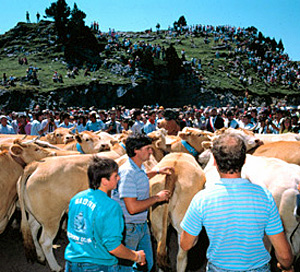
Villagers from Bearn prepare to drive up a herd of cattle
to the Ernaz Stone on July 13. Below, in good weather, large crowds assist at ceremony
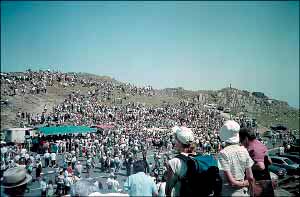
|
A servant, however, escaped and sounded the alarm in the village of Arette. Its men gathered together and hid themselves at a pass the Roncalese would cross on their return. Then, when the latter passed, they were all silently stabbed in the dark.
With such a ferocious start, one can imagine the war of revenge between the two valleys that followed. Alarmed, the sovereigns of both countries attempted to reestablish the peace, ordering that a meeting be held at which both sides should submit their quarrels to the higher authorities. The two sovereigns – Charles II of Navarre and Gaston, Prince of Bearn – met at the village of Ansó, each accompanied by two Bishops. But all attempts to establish peace were futile. The two valleys continued their bloody feud until it was finally settled after the especially violent Battle of Aguincea.
Finally, the inhabitants of Baretous gave way and sent a messenger to the Roncalese asking for a truce, promising to submit to the decision of the Aragonese village of Ansó. The Roncalese accepted. After a hearing at which both sides presented their complaints and demands, the tribunal determined that the damage should be considered equal on both sides, but that the Roncalese should receive a yearly tribute of three cows from the Baretous Valley. The date of July 13 was proposed and accepted by both sides. The villages of Ansó and Olorón stood as surety to the Roncalese that the agreement would be kept, offering as pledge the parish church and the cathedral, respectively.
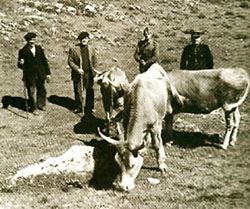
Every year sees the fulfillment of the tribute of the three cows |
The Roncalese sustain that this feud was not the origin of the tribute, but rather that the tribunal had merely re-established a much older tribute that had ceased to be made. The rupture in the payment, according to this version, was one of the causes of the war.
Regardless of its origin, since the settlement of that feud on July 13, 1375, the tribute was re-assumed and has never been interrupted to our days. In 1794, during the war between Spain and France (War of the Convention), the village of Baretous tried to stop paying the tribute. However, it was judged that the tribute was a private affair between the two valleys, and that neither Navarre nor Bearn, nor Spain nor France, had anything to do with it. Therefore, it was ordered that the Baretous representatives go to Isaba with their tribute of three cows without further excuse or delay. And so they did.
In 1944 the German army occupying southern France forbade the ceremony, fearing the French delegation would flee to Spain. The next year, the inhabitants of Baretous returned to the custom, paying also the missing year, but the Roncalese only accepted two cows for that year, returning the third in consideration for the difficult circumstances they had passed through.
Based on an translated from Rafael Gambra, El Valle de Roncal,
Estela, Navarra: Graficas Lizarra, 1987, pp. 12-17
Posted July 10, 2007


These two descriptions of the privileges of the Roncal Valley, which I translated from Spanish and edited, provide an extraordinary confirmation of the principles of organic society. Indeed, the Roncalese with their vibrant and picturesque history, are examples of the richness of medieval life, be it the great kingdoms or the small towns. Each one had its own personality, abounding with its peculiar characteristics, and offering a history made up of inequalities, special traditions and customs.

Witnesses from Roncal Valley, all noble,
in traditional garb of the village of Anso |
The revolutionary man tries to instill hatred for social hierarchy, privileges and traditions because they would be, he wrongly asserts, characteristics only of the aristocrats, far removed from the people. Thus, to truly favor the people one should be against nobles and privileges.
With these examples taken from the history of the Roncalese, we see how partial and incorrect such criticisms are. Fidelity to the true Faith is the foundation of the nobility of the Roncal people, and a long history of complex facts justifies their privileges and traditions. Similar things took place in the histories of every noble house in Europe, be it sovereign or not.
The same man who boldly criticizes privileges and nobility for their place at the top of the social hierarchy must remain silent before the noble-peasants of the Roncal Valley. They are noble, but they are also people, the modest villagers and shepherds.
The noble-peasants of Roncal Valley not only provide a good argument in face of this revolutionary hatred for inequalities. It also offers the explanation for the very root of nobility. It provides us a microscopic picture of the Middle Ages, in all its health and strength, its richness and beauty.
H.R.

Related Topics of Interest
 The Peasant-Nobles of the Roncal Valley - Part I The Peasant-Nobles of the Roncal Valley - Part I
 The Organic Formation of Groups of Friends The Organic Formation of Groups of Friends
 Vocations of the European Peoples Vocations of the European Peoples
 The Role of Admiration and Affection in the Family The Role of Admiration and Affection in the Family
 What Is Organic Society? What Is Organic Society?
 The Steps of an Organic Relationship The Steps of an Organic Relationship
 Organic Society and Desire of Heaven Organic Society and Desire of Heaven
 The Moon and its Halo The Moon and its Halo
 Departure for the Crusade: A Desire for Sublimity Departure for the Crusade: A Desire for Sublimity

|
Organic Society | Social-Political | Home | Books | CDs | Search | Contact Us | Donate

© 2002- Tradition in Action, Inc. All Rights Reserved
|
 |
|